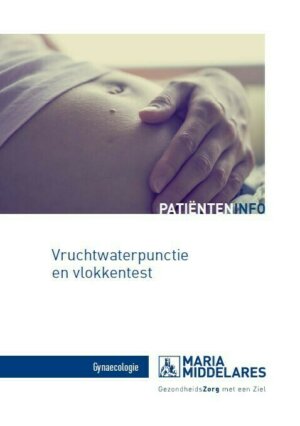Amniocentesis
What is it?
What is it?For amniocentesis, approximately 20 ml of amniotic fluid is collected. This can be done from week 15 of pregnancy. The amniotic fluid contains cells that have been shed by the baby and that always correctly reflect the child’s karotype. These chromosomes are examined using an array. An abnormal NIPT result will always be confirmed by means of amniocentesis from 15 weeks. Chorionic villus sampling is not meaningful in this case.
You do need to be concerned about this procedure. The puncture for amniocentesis is comparable to the one for blood tests: you will only feel a sting in the skin. During amniocentesis, you do not feel any pain when the amniotic fluid is withdrawn and the entire procedure takes approximately 20 seconds.
Strict, sterile precautions are taken to keep the risk of infection to a minimum. Ultrasound is used to visualise the puncture so you can follow the procedure on the screen if you wish.
Purpose of the procedure
The purpose of chorionic-villus-sampling/amniocentesis usually is to determine the karyotype of the baby. Reasons for this include:
- An abnormal NIPT test In this case, only amniocentesis is useful.
- An increased risk of a chromosomal abnormality after a nuchal translucency measurement and/or blood tests of the mother (the combined test).
- An abnormality in the baby that has been identified through an ultrasound.
- The occurrence of a well-defined hereditary disease in the family is always established after prior consultation.
- Maria Middelares General Hospital consults with its Medical Genetics Centre. Your gynaecologist will discuss this with Dr Casteels in advance or refer you in the first trimester for further consultation.
- St Vincent General Hospital in Deinze consults with the prenatal diagnostic service at Ghent University Hospital. Your gynaecologist will discuss this in advance with Dr Roets (Ghent University Hospital) or refer you for further consultation in the first trimester.
- If the reason for amniocentesis is an infection with toxoplasmosis or CMV (cytomegalovirus), you may choose to have a chromosome test at the same time. This requires the collection of more amniotic fluid, without causing any increased risk of miscarriage. You may discuss this with your gynaecologist and/or Dr Casteels.
For a swift and accurate assessment of the results of the prenatal tests, we will also ask for blood samples from both parents. This is done at the same time as chorionic villus sampling or amniocentesis.
There are however also serious chromosomal abnormalities that are not visible on a classic karotype. As some of these smaller chromosomal abnormalities may have serious consequences too, all genetic centres have been using a new test since 1 May 2013. This test is known as a microarray or molecular karotype. The cells collected through chorionic villus sampling or amniocentesis will not be subjected to classic karotype testing but to microarray testing instead. This test allows for the detection of smaller chromosomal abnormalities too.
Course of the procedure
Course of the procedureYou will first have an informative meeting about the details of the procedure. There will be ample opportunity to discuss any questions you may have. Using the information leaflet that you can read in advance, you will be able to ask targeted questions. Next, an ultrasound is carried out, followed by the amniocentesis. Blood samples will be collected from both parents at the Blood Testing Unit. Fasting is not necessary for this. If the mother’s blood type is rhesus negative and the father’s is rhesus positive, the mother will also be administered a RhoGAM injection. This will prevent the mother from producing antibodies to the rhesus factor as a result of the procedure.
You may go home immediately after the test. You will be given a medical certificate for two days’ sick leave. If required, your partner can ask for a written confirmation of attendance for the consultation.
Please bring the following documents with you:
- identity card
- the mother’s blood type card
- physician/gynaecologist referral letter (if applicable)
- you do not need to bring money, as you will receive an invoice in the post
Possible risks
Possible risksBoth procedures, amniocentesis as well as chorionic villus sampling, have a small associated risk of miscarriage, which is approximately 0.5%. This is related to the possibility of infection, bleeding or loss of amniotic fluid (therefore, not related to the baby being touched). During the procedures, an ultrasound scan is used for visualisation and you will be able to view the procedure being performed on the screen.
You may go home immediately after the procedure. You will have two days’ sick leave, that is the day of the procedure itself and the following day. We recommend to take it easy during those two days: no strenuous effort (e.g. cleaning, lifting children) or long walks. You do not need to observe bed rest: small activities such as a little cooking or desk work are permitted. After the two days, you can resume your normal activities.
You may experience a slight tummy ache on the day after the procedure (like menstrual pain). This is completely normal. You are free to take pain relief (preferably paracetamol). If you take it easy, the pain will disappear by itself over the course of the day. You should not have any significant symptoms the following day. Contact your gynaecologist in case you have any of the following symptoms (in the days following the amniocentesis procedure): loss of amniotic fluid, blood loss, persistent tummy pain or fever.
Results
ResultsMaria Middelares General Hospital
The results of the chorionic villus sampling/amniocentesis will be sent directly from the Medical Genetics Centre Ghent to your gynaecologist.
- For each procedure performed on a Monday, Tuesday or Wednesday you may contact your gynaecologist on the Friday after 4pm. If you are unable to reach your gynaecologist you may also telephone the secretariat of Dr Casteels (+32 (0)9 220 30 88) or the Medical Genetics Centre directly, until 5pm (+32 (0)9 332 36 03).
- If the procedure is performed on a Thursday or Friday, the results will only be known on the following Friday.
St Vincent General Hospital in Deinze
The physicians at Ghent University Hospital pass on the result directly to the patient on the one hand (a contact time is agreed), and the gynaecologist at St Vincent General Hospital in Deinze on the other.
The amniocentesis confirms an abnormality. What now?
You will be referred to a paediatrician and/or clinical geneticist for a more detailed explanation about the possible consequences.
Leaflet
LeafletOnly available in Dutch:

Vruchtwaterpunctie en vlokkentest
DownloadCentres and specialist areas
Centres and specialist areasLatest publication date: 16/05/2024



